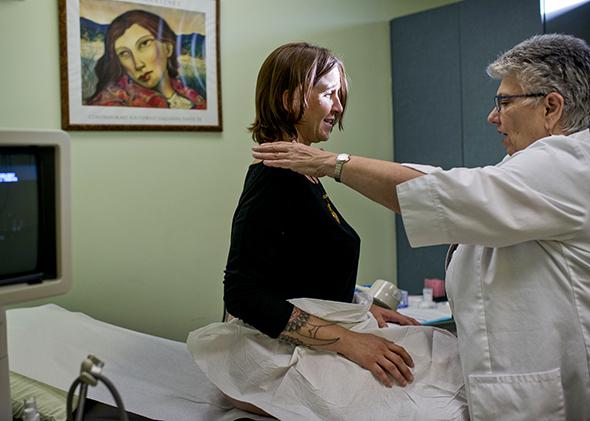Last week’s Supreme Court ruling in the Hobby Lobby case may keep access to contraception out of reach for many women. In sharp contrast, a new program in Oregon puts reproductive health care front and center for all women.
The Oregon initiative, called One Key Question, aims to make sure that during each medical visit, a woman of reproductive age is asked: “Would you like to become pregnant in the next year?”
The answer triggers a doctor-patient discussion that will keep women healthier, help eliminate health disparities, and save taxpayer dollars.
If a patient hopes to conceive within the next year, the doctor or other medical care provider offers counseling and resources to ensure that her future pregnancy is as healthy as possible.
If a woman does not intend to get pregnant, the doctor starts a conversation with her about the full range of contraceptive options available to prevent an unplanned pregnancy. (About 85 percent of couples not using contraception will become pregnant in the next year, whether they intend to or not.)
If a woman is uncertain, the health care provider encourages her to take preventive measures until she’s sure. The goal is to put pregnancy intentions on the radar screen of primary care so that a greater proportion of pregnancies are wanted, planned, and healthy.
The idea makes sense from a practical perspective. Most women are fertile for about 35 years. That means a woman who desires two children will spend three decades of her life trying to prevent an unintended pregnancy. Fortunately, contraceptives and counseling are still recognized as core preventive health care services under the Affordable Care Act. How they will be provided has to be worked out after the Supreme Court’s bow to bosses’ religious assertions and the court’s subsequent injunction allowing Wheaton College to refuse to comply with a workaround for religious groups. Insurance companies are still obligated to cover contraceptives, with no co-pay.
On the flip side, a woman who does want to become pregnant needs services, starting with simple preconception care and transitioning to early prenatal care. Problems affecting a woman’s health, such as obesity, diabetes, or high blood pressure, are best addressed before she becomes pregnant to increase the chances of a healthy outcome.
This simple approach was designed by the Oregon Foundation for Reproductive Health with funding from the Ms. Foundation. (OFRH and the Ms. Foundation are our employers.) Over the past several years, OFRH has implemented pilot projects in primary care clinics in the Portland, Oregon, area and assisted in the integration of One Key Question into health care sites statewide and in select trials in seven other states.*
Care providers for low-income women in Oregon, including home visiting staff, Women, Infants, and Children programs, and the Immigrant and Refugee Community Organization, are starting to routinely ask families One Key Question at intake. National professional organizations are taking note as well, with the American Public Health Association and the National Association of Nurse Practitioners in Women’s Health expressing their support.
Data collection about the effectiveness of One Key Question has just begun, but so far it demonstrates a significant increase in three essential indicators: an increase in the proportion of women who do not want to become pregnant who are using contraception; an increase in the use of long-acting reversible contraceptive methods, such as intrauterine devices or hormonal implants; and an increase in the proportion of women who want to be pregnant who are receiving preconception care and/or taking folic acid to reduce the risk of spinal cord malformations.
The project could have outsize benefits for low-income women, those who live in rural areas, and women of color. These women have higher rates of unintended pregnancy, and thus higher rates of negative health outcomes for them and their children. In the United States, women of color are four times more likely than white women to die from pregnancy- or childbirth-related conditions. Unintended pregnancy increases financial stressors for families and can derail women from educational and employment opportunities.
In the same way that health care providers routinely screen adults for cancer, high blood pressure, or depression, they must proactively discuss the reproductive health care needs with women of reproductive age. At every visit, a doctor should take into account that a woman’s best option for receiving reproductive health care may be right there with her primary care provider—family planning clinics and OB-GYNs are out of reach for many women.
Supporting women in making these momentous decisions has enormous cost-saving potential for society. Dollars spent on preventive reproductive health care save money on unintended pregnancies and the health care that follows. Healthier pregnancies and births reduce costs for families, the government, and the private sector now and in the future. But the biggest benefit is in helping women and families to be healthier.
By asking the One Key Question, Oregon has taken a giant leap forward toward the goal of enabling a woman’s right to affordable, accessible, comprehensive health care. This straightforward model easily and affordably incorporates contraception as a preventive service. Health boards and medical professionals in other states would do well to follow Oregon’s lead and adopt this critical question for women’s well-being.
If your doctor hasn’t asked you about your pregnancy intentions yet, consider asking your doctor a question of your own: “Why not?”
Helen Bellanca, MD, a medical adviser to the Oregon Foundation for Reproductive Health, contributed to this article.
Correction, July 9, 2014: This article originally stated that One Key Question helps providers comply with a new quality metric for health care in Oregon that requires sites to report the proportion of women in their practices who are using effective contraception (among those who do not want to become pregnant). In fact, although sites may be required to report this data in the future, at present data about contraception use is collected through telephone surveys. The original sentence has been removed. (Return.)
